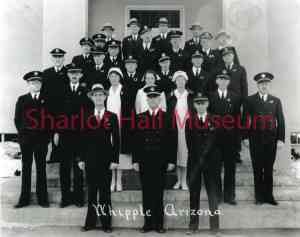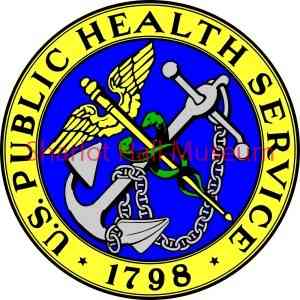by Worcester P. Bong
 Over the past 200 plus years, the U.S. Public Health Service (USPHS) has been tasked to protect, promote and advance the health and safety of our country. Created in 1798 as the Public Health and Marine Hospital Service, they focused on protecting against the spread of disease from sailors returning from foreign ports and maintaining the health of immigrants entering the country. In 1912 Public Health and Marine Hospital Service was shortened to the U.S. Public Health Service. Congress broadened USPHS scope by authorizing investigations into human diseases (such as tuberculosis, malaria, typhus fever and leprosy), sanitation, water supplies and sewage disposal. The USPHS coordinated with other nations to address public health issues.
Over the past 200 plus years, the U.S. Public Health Service (USPHS) has been tasked to protect, promote and advance the health and safety of our country. Created in 1798 as the Public Health and Marine Hospital Service, they focused on protecting against the spread of disease from sailors returning from foreign ports and maintaining the health of immigrants entering the country. In 1912 Public Health and Marine Hospital Service was shortened to the U.S. Public Health Service. Congress broadened USPHS scope by authorizing investigations into human diseases (such as tuberculosis, malaria, typhus fever and leprosy), sanitation, water supplies and sewage disposal. The USPHS coordinated with other nations to address public health issues.
After World War I, the role of the USPHS expanded to provide care for disabled and sick soldiers, sailors and marines. Thus the transition of U.S. military hospitals managed by USPHS took place.
Here in Prescott, on February 15, 1920, the Secretary of War loaned Whipple Barracks, U.S. Army General Hospital #20 to the USPHS. The February 18, 1920 edition of the Weekly Journal-Miner reported that Colonel Raymond W. Bliss, Commanding Officer, conducted this transfer without a ceremony. Colonel Bliss remained a few days to finalize the transfer and then relocated to Denver, Colorado for his new assignment. As a result, Whipple Barracks was re-designated USPHS Hospital #50. Federal funding was provided for additional construction and renovations. On June 30, 1920 USPHS officially assumed control of Whipple Barracks along with 42 other military hospital facilities around the country. The facilities were categorized into general, neuro-psychiatric or tuberculosis type of hospital services. Thirteen districts were set up to manage the USPHS hospitals—the states of Arizona, California and Nevada were under District 12. Whipple Barracks continued its focus as a tuberculosis hospital. Surgeon Dr. Robert H. Stanley was the Medical Officer in charge. Numerous new structures and tuberculosis wards were built, which increased the bed count to 900. The facility was one of the most complete tuberculosis sanatoriums in the country.
Concurrent to USPHS, another set of federal programs— the Veterans Bureau, Bureau of Pensions of the Interior Department and National Home for Disabled Volunteer Soldiers— administered various veterans’ benefits. On August 9, 1921 by Public Act No. 47 (H.R. 6611, Sweet bill), Congress combined these federal programs to create the Veterans Bureau.
 On April 29, 1922, President Harding issued Executive Order 3669 that transferred hospitals from USPHS to the Veterans Bureau. Whipple Barracks in Prescott was one of these hospitals. Major Dr. Gail D. Allee was the Commanding Officer. The Veterans Bureau provided funding to Whipple Barracks as part of the first Langley Act, which resulted in improvements to buildings and demolition of older buildings.
On April 29, 1922, President Harding issued Executive Order 3669 that transferred hospitals from USPHS to the Veterans Bureau. Whipple Barracks in Prescott was one of these hospitals. Major Dr. Gail D. Allee was the Commanding Officer. The Veterans Bureau provided funding to Whipple Barracks as part of the first Langley Act, which resulted in improvements to buildings and demolition of older buildings.
Transitioning further, the Veterans Bureau became the Veterans Administration (VA) when President Hoover signed Executive Order 5398 on July 21, 1930. Brigadier General Frank T. Hines, who had directed the Veterans Bureau for seven years, was named the first Administrator to oversee the entire VA organization.
For Whipple Barracks, the official transfer of title from the War Department to the VA occurred on March 3, 1931. The March 4, 1931 edition of the Prescott Evening Courier stated “the transfer of title is now law and telegrams of this announcement were sent to Arizona Congressmen, the Yavapai County Chamber of Commerce, and representatives of local veterans’ organizations.”
Thus concludes the eleven-year transition period in which the USPHS and Veterans Bureau were caretakers of the Whipple Barracks hospital in Prescott prior to it becoming a VA hospital facility.
To learn more, come listen to Worcester P. Bong’s lecture 5/6/2023 at 2 pm at the Sharlot Hall Museum in the Education Center Auditorium. Tickets are $15 or FREE for museum members. Seating is limited.
“Days Past” is a collaborative project of the Sharlot Hall Museum and the Prescott Corral of Westerners International (www.prescottcorral.org). This and other Days Past articles are also available at www.archives.sharlothallmuseum.org/articles/days-past-articles/1 The public is encouraged to submit proposed articles and inquiries to dayspast@sharlothallmuseum.org Please contact SHM Research Center reference desk at 928-277-2003, or via email at archivesrequest@sharlothallmuseum.org for information or assistance with photo requests


